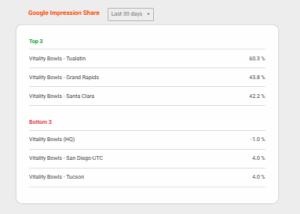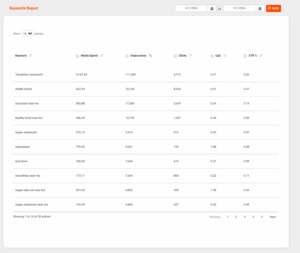PPC Ad Management Software: A Tool for Building Marketing Systems for Franchise Brands
Franchise marketing is a unique discipline that requires thinking locally, acting globally (or nationally), and then again thinking and acting locally. For franchise marketing teams, leveraging PPC management software is a transformative tool that simplifies the often headspinning demands of marketing a large franchise brand. By consolidating and analyzing data across various franchise locations, brands can develop proprietary insights that inform tailored marketing systems to enhance operational efficiency and drive growth. This approach not only optimizes current marketing efforts but also lays the groundwork for scalable success in franchise development and new parallel brand launches.
Harnessing PPC Ad Management Software for Strategic Advantage
PPC management software generates a wealth of data points, including Cost Per Lead (CPL), click-through rates, conversion rates, CPM, and more. When aggregated across multiple franchise locations, this data offers a comprehensive view of performance metrics, enabling brands to identify patterns and trends that are not apparent when analyzing individual locations in isolation. While these data points are all important to refining campaigns and strategy, franchise marketing teams and the franchisees they work with are typically focused on CPL because it immediately reflects their efforts to drive ROI.
Geo-Targeting and CPL Analysis
Understanding CPL variations across different regions is crucial. By analyzing this data, franchise brands can allocate budgets more effectively, focusing on areas with lower CPLs to maximize return on investment. For instance, if a particular city consistently shows a lower CPL, it may indicate a higher demand or better market fit, suggesting an opportunity for increased marketing efforts or even expansion in that area.
Seasonality Insights
PPC management software can reveal seasonal trends specific to different locations. For example, a lawn care franchise might notice increased search volumes and conversions in southern states during early spring, while northern states peak later. Recognizing these patterns allows brands to time their marketing campaigns and pace their budgets to coincide with local demand, optimizing ad spend and improving lead generation.
Generate and Maintain Proprietary Brand Keyword Data
Analyzing keyword performance across multiple locations and cross referencing by location helps in understanding regional language nuances and preferences. Using PPC management software franchise brands can test and refine their keyword selections based on aggregated performance data across multiple units. With standardized keywords in place brands can then set regional and local strategies. Certain terms may resonate more in specific areas; for instance, what are commonly referred to as “gutters” in most of the U.S. are referred to as “eaves” in parts of the West and Inland North and “rainspouting” in Pennsylvania and Maryland. Tailoring ad copy, keyword and long-tail keyword targeting, and landing pages to reflect these local terminologies can help franchise brands build regional PPC strategies informed by nuance and enhanced by national performance data.
Enhancing Performance Max Campaigns
Traditional Google Search campaigns accumulate valuable data over time, which can be instrumental when transitioning to Google’s Performance Max campaigns. Performance Max leverages Google’s AI to optimize ad placements across various channels. Feeding it with historical data from Search campaigns enables more efficient learning and better performance, as the AI can make informed decisions based on past insights.
Developing Replicable Systems for Franchise Growth
The insights gained from PPC management software analysis can be standardized into replicable marketing systems. By identifying what works best across different locations, brands can create playbooks that guide new franchisees, ensuring consistency and efficiency in marketing efforts. This not only aids in selling new franchise territories by showcasing a proven marketing strategy but also supports the successful launch of new brands targeting similar demographics.
Case Study: PPC Ad Management Software for Home Services Brands
Consider a home services franchise catering to suburban homeowners. By analyzing data from PPC management software, the brand might discover that certain services, like gutter cleaning (also known as eave cleaning or rainspout cleaning), have higher demand in regions with heavy foliage. This insight allows for targeted advertising in those areas, emphasizing relevant services. Furthermore, understanding the homeowner demographics through PPC data can inform the development of complementary services or brands that address related needs, such as landscaping or pest control.
Additional Applications of PPC Ad Management Software
Budget Optimization and Ad Scheduling: Analyzing when ads perform best across different locations can inform ad scheduling and budget pacing, ensuring that ad budgets prioritize peak engagement times (Search Engine Journal).
Competitor Benchmarking: PPC management software can reveal how a franchise’s ads perform relative to competitors in various regions, highlighting areas where the brand has a competitive advantage or needs improvement.
Audience Segmentation: Detailed analysis of PPC data allows for the segmentation of audiences based on behavior and demographics, enabling more personalized and effective marketing strategies.
Budget Allocation: Insights into which locations yield the highest return on ad spend can guide strategic budget allocation, focusing resources where ROI can be most improved.
Case Study: PPC Ad Management Software for Restaurant Brands
Consider a restaurant franchise with multiple locations across urban and suburban areas. By analyzing data from their PPC management software, the brand identifies that lunch-hour mobile searches for “fast healthy meals” peak around office-heavy districts, while evening traffic surges near residential neighborhoods focus on “family dinner deals” and “takeout specials”.
This insight empowers the brand to create geo-targeted ad campaigns—highlighting quick service and nutrition during work hours in city centers, and promoting family combo meals or kids-eat-free offers in suburban zones during dinnertime.
Further, keyword trend analysis reveals a growing interest in plant-based options, prompting the marketing team to test new menu items and promote them via PPC ads. Combined with demographic data, these insights help shape not only more effective advertising but also influence menu development, pricing strategies, and even location planning for future restaurant expansions.
Using Local Terminology to Improve Keyword Targeting
For international restaurant brands, recognizing and adapting to regional language differences is crucial for effective local PPC campaigns. For example, in the U.S., someone searching for a sandwich might use the term hoagie in Philadelphia, grinder in parts of New England, or sub elsewhere. A smart PPC strategy will include all relevant variants in each geographic region’s keyword set to match how people naturally search.
Similarly, in parts of the UK, dinner can refer to the midday meal (what many would call lunch), while tea might mean the evening meal. Failing to account for these local nuances can lead to mismatched ad copy or irrelevant impressions.
Utilizing Ad Position Data to Assess Market Saturation and Competition
Tracking ad position data in PPC campaigns offers valuable insights into the competitive landscape and market saturation within specific local markets. Ad position refers to the order in which your ad appears on the search engine results page, with a lower number indicating a higher placement.
Consistently low ad positions may indicate a highly saturated market with numerous competitors bidding on the same keywords. In such scenarios, the CPC is likely to be higher due to increased competition. Recognizing these patterns allows brands to evaluate whether investing heavily in these markets yields a favorable ROI or if resources should be reallocated to less saturated areas.
Conversely, achieving higher ad positions at a reasonable CPC suggests less competition, presenting opportunities for more cost-effective customer acquisition. Regular analysis of ad position data enables brands to make informed decisions about budget allocation, bidding strategies, and market expansion.

Conclusion
Building proprietary brand data through comprehensive analysis provided by PPC management software empowers franchise brands to craft location-specific marketing strategies, optimize advertising efforts, and establish systems that drive consistent success. This data-driven approach not only enhances current operations but also provides a solid foundation for future growth, whether through expanding existing franchises or launching new brands targeting similar demographics.
Why Adplorer Is the Ideal PPC Ad Management Software for Franchise Brands
If you’re looking to turn insights into real, scalable action—Adplorer is built for exactly this kind of work. Our all-in-one PPC management software is designed specifically for multi-location and franchise businesses. From geo-targeted campaign creation and optimization to automated budget allocation, aggregated keyword reporting, and CRM-integrated lead attribution, Adplorer empowers both corporate marketing teams and franchisees to run better, smarter campaigns.

With Adplorer, you don’t just get visibility into CPLs across markets—you get tools to lower them, playbooks to replicate top-performing strategies, and dashboards that bring national performance and local nuance together in one place. Plus, with built-in reporting, billing automation, and support for Google, Meta, Microsoft Bing Ads, YouTube Ads, LinkedIn Ads, Spotify Ads and more—Adplorer makes managing thousands of localized campaigns not just possible, but easy.
Ready to build your franchise marketing system with smarter software? Schedule a demo and see how Adplorer helps franchise brands grow faster—locally and at scale.


